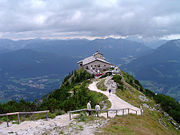Kehlsteinhaus


The Kehlsteinhaus (in English-speaking countries also known as the Eagle's Nest), is a chalet-style building which when built was an extension of the Obersalzberg complex built by the Nazis in the German Alps near Berchtesgaden. The Kehlsteinhaus was an official 50th birthday present for Adolf Hitler. Nicknamed Eagle's Nest by a French diplomat, it was meant to be a retreat for Hitler and a place for him to entertain visiting dignitaries.
Contents |
Construction and usage
It was commissioned by Martin Bormann, with construction proceeding over a 13-month period prior to its formal presentation to Hitler in 1939. It is situated on a ridge at the top of the Kehlstein mountain (1834 m), reached by a spectacular 6.5 km (3.9 mile) road that cost 30 million Reichsmark to build (about 150 million euros in 2007, adjusted in line with inflation). The last 124 metres up to the Kehlsteinhaus are reached by an elevator bored straight down through the mountain and linked through a long granite tunnel below. The inside of the large elevator car is surfaced with polished brass, Venetian mirrors and green leather (the elevator is still used daily). Construction of the mountain elevator system cost the lives of 12 construction workers [1]. The main reception room is dominated by a fireplace of red Italian marble, presented by Mussolini. Much of the furniture was designed by Paul Laszlo.
The Kehlsteinhaus was built as a 50th birthday present for Adolf Hitler. Nicknamed Eagle's Nest by a French diplomat, it was meant to be a retreat for Hitler and a place for him to entertain visiting dignitaries. The building is also often called "Hitler's Tea House", but this is a misnomer. Hitler did not treat the Kehlsteinhaus as a tea house, and the location he visited daily for afternoon tea was actually the Mooslahnerkopf Teehaus.
Although the site is on the same mountain as the Berghof, Hitler rarely visited the property. It has been suggested he only visited the Kehlsteinhaus around 10 times, and most times for no more than 30 minutes. Perhaps because of this lack of close association with Hitler, the property was saved from demolition at the end of the war.

Allied capture
Dwight D. Eisenhower, Supreme Commander of the Allied forces in Europe and later President of the United States, wrote that the U.S. Army's 3rd Infantry Division was the first to take the Eagle's Nest.[2] General Maxwell D. Taylor, former Commanding General of the 101st Airborne Division, stated the same.[3] Photographs and newsreel footage show 3rd Infantry soldiers relaxing on the Eagle's Nest patio, "drinking Hitler's wine", affirming that they were present at the house in May 1945.[4]
Other groups claiming to be first there include Easy Company of the 2nd Battalion 506th Regiment and the French 9th Armoured Company (which was composed of Spanish Republican volunteers). The Kehlsteinhaus' museum states that it was captured by a member unit of the U.S. 101st Airborne Division and includes a picture of the unit's shoulder sleeve insignia.
French general Georges Buis claimed two free French officers of the 2nd Armoured Division, himself and Paul Repiton-Preneuf, were the first to arrive at the Kehlsteinhaus. He said the two arrived early in the morning and slipped away shortly thereafter when they saw both French and American troops arriving.[5]
According to a local guide the Kehlsteinhaus was to be the aiming point of an Royal Air Force bombing raid on April 25, 1945. However the small house proved an elusive target and the Berghof area was targeted instead and severely damaged. Several anti-aircraft positions, the base plate of one of which is still discernible, were present about 100 meters further up the ridge behind the Kehlsteinhaus.
Current use

The Kehlsteinhaus was subsequently used by the Allies as a military command post until 1960, when it was handed back to the State of Bavaria.
Today the building is owned by a charitable trust, and serves as a restaurant. It is a popular tourist attraction, particularly for Britons and Americans attracted by the historical significance of the "Eagle's Nest". The house can be reached on foot (two hours of walking), or by bus.
After the return of the Kehlsteinhaus to German hands, an information centre was built on the foot of the hill to remind the public of Hitler and his regime. The Kehlsteinhaus itself does not mention much about its past.
Informal tours of Kehlsteinhaus are offered by a local guide to foreigners arriving by local bus at the lower elevator station. The tour is not offered in German, apparently a requirement due to previous trouble with neo-Nazis and post-war Nazi sympathisers.
The lower rooms, with spectacular views out of plate-glass windows, are not part of the restaurant but can be visited with a guide. Graffiti left by allied troops is still clearly visible in the surrounding woodwork. Hitler's small study is now a store room for the cafeteria.
See also
- Führer Headquarters
References
- ↑ "Adolf Hitler", Current Biography 1941, p384
- ↑ Dwight D. Eisenhower, Crusade in Europe 418 (1948) (The exact quote from page 418 reads "On May 4 the 3d division of the same corps captured Berchtesgaden." The corps mentioned was the US XV Corps. The term "Eagle's Nest" is not in the quote nor the paragraph that mentions the capture of Berchtesgaden.
- ↑ Maxwell D. Taylor, Swords and Plowshares 106 (1972)
- ↑ Pfc. James Cromwell (May 15 2003). "Photos summon image of 3ID's past", Frontline (Third Infantry Division newspaper). Retrieved on 2007-06-14.
- ↑ General Georges Buis Les fanfares perdues 1975